24 Enlightening Chatbot Statistics You Should Know In 2024
There’s no denying it:
Chatbot technology is the future of marketing and lead generation for a lot of businesses.
Truth is, there are already plenty of businesses that have it in place for finding potential customers.
The only question is:
Should you be using chatbots in your business?
In this post, we’ll cover the most important chatbot statistics and facts that you can use to learn more about how you can use them to improve your sales and make your operations more efficient.
Chatbot usage statistics and facts
Chatbots made a positive impact on most businesses and their customers. In this section, you’ll find statistics that would give you a better sense of how the technology is being used today as well as where it’s headed.
Here are a couple of chatbot statistics on how the technology is being used today.
1. 80% of marketers planned on using chatbots
In 2019, marketers expressed a desire to use chatbots in some capacity by the following year. This is due to the fact that they’re so versatile. It also helps that they are useful as digital tools across multiple industries and job types.
Other reasons that chatbots are considered instrumental for business growth is their ability to reduce operational costs and increase the quality of communication through messenger channels. It’s capable of reducing customer support costs and alleviating some of the pressure that customer service agents face.
There are other chatbot features worth exploring since they are still relatively new technology.
Source: Forbes
2. People use chatbots to combat Covid-19
Chatbots have been instrumental in helping fight misinformation about Covid-19. These had been considered effective because it manages to curate information and customize it based on the needs of internet users.
It’s also good that chatbots are able to answer in an interactive manner which makes them faster and more responsive than traditional online searches.
Chatbots are being utilized by two of the most authoritative sources of Covid-19 information — The World Health Organization (WHO) and the Center for Disease Control (CDC).
Source: World Economic Forum
3. 16% of banking institutions plan on investing in chatbots
According to a survey, 16% of banking institutions plan on investing in chatbots in 2021. Before the pandemic hit, the number of banks that used chatbots rose from 4% to 13%. It’s a small indication that chatbots are slowly being embraced by the banking community.
Chatbots are ideal for taking away basic queries such as checking account balances or changing addresses. This gives live agents a better chance to respond to more pressing concerns and for organizations to improve customer service.
Source: The Financial Brand
4. Charity organizations also use chatbots
Charity organizations are now using chatbots as part of their response to Covid-19. This technology is one of the reasons why they are still operating while dealing with fewer staff members and dwindling resources.
Thanks to AI, chatbots are able to handle simple, repetitive tasks. For instance, they can answer frequently asked questions. This frees up staff members to focus on other matters.
The most common chatbots used by charities are those from Facebook Messenger although other solutions exist.
Source: Charity Digital
5. 40% of shoppers don’t mind chatbots
40% of shoppers said that they don’t care if they’re helped by chatbots (AI) or by a human. But there’s a caveat. They couldn’t care less whoever or whatever helps them so long as their questions get answered.
To add to that, 47% expressed that they’re interested in buying products through bots. In comparison, only 37% said that they’re willing to make purchases through social media.
Source: HubSpot
6. 38% of consumers had a positive experience with chatbots
Out of 5,000 consumers from six countries, 38% rated their chatbot experience as a positive one according to a recent survey. Only 11% had a negative experience while 51% were neutral.
67% of these consumers used chatbots for customer service support. However, only 14% used chatbots for tasks such as scheduling and other productivity purposes.
European users are more open to using chatbots with 50% of respondents from France liking the chatbot experience. Users from Japan and the United States were the least receptive.
Source: Business Insider
7. The chatbot market will exceed $1.34 billion by 2024
There’s an assumption that the chatbot market will exceed $1.34 billion by 2024. The reason behind it is that Ai platforms and voice-driven AI have become a necessity for brands that would like to offer a consistent brand experience to customers.
While live agents are only able to handle two or three conversations at a time, chatbots have the ability to handle more than that. There’s no limit as to how many conversations can take place at a given time.
Using chatbot technology can save businesses up to 30% of their costs.
Source: Chatbots Journal
8. The primary use case for chatbots is getting faster answers
The biggest reason why people are starting to like chatbots is that they’re able to get answers more quickly. This is not something consumers get on a consistent basis from human interactions.
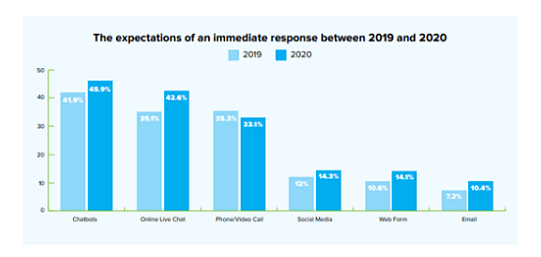
It appears that 45.9% of consumers expect chatbots to deliver an immediate response to their questions or concerns.
Source: Startup Bonsai
9. 80% of users have dealt with a chatbot at some point
There’s no escaping chatbots as it’s slowly becoming part of the norm. According to a study, 80% of people have interacted with a chatbot at some point.
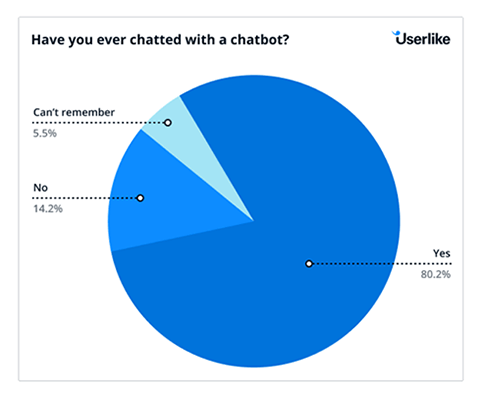
And because of that level of exposure, consumers are now becoming more comfortable interacting with chatbots. This will only help the technology grow.
Source: Blogging Wizard
Businesses and chatbots: statistics and facts
The benefits of using chatbots are not lost on many companies — especially the bigger ones. Microsoft, Facebook, and Google are already investing time and money into chatbots in hopes that they can leverage the technology for their own purposes.
Here are some facts and statistics on what businesses are doing with chatbots and how they can help companies down the road.
10. Microsoft is getting into the chatbot business
While it might seem bizarre, Microsoft applied for and granted a patent that will allow it to explore the possibility of creating AI chatbots from dead loved ones.
Its technology will use images, voice data, social media posts, electronic messages, and other types of data to create an index in the likes of someone’s personality. It can even create a 3D rendering of the person for added realism.
Source: CNET
11. Facebook is developing chatbots with empathy
Facebook is currently developing a chatbot it’s calling Blender. And if things go according to plan, this chatbot will be able to combine a huge amount of training data with artificial empathy, general knowledge, and maybe even show some personality.
The company is making the most of the recent advances in AI and language technology to do this. Facebook released snippets showing the chatbot engaging with people about Game of Thrones and vegetarianism.
Source: Wired
12. Google is developing chatbots as well
Google is yet another company that’s joining the chatbot race as it’s developing one that’s able to recognize more patterns of conversation.
What that means for users is that soon—if things go according to plan—they will be able to have a discussion with a chatbot that can understand and respond to queries the same way a regular person would.

Google’s latest chatbot model is called Meena and it can conduct conversations that are more sensible than existing chatbots.
Source: Social Media Today
13. Facebook has over 300,000 bots
Facebook reached a milestone back in 2018 when it revealed that it has more than 300,000 chatbots on its platform. That’s impressive considering it only had 100,000 the year before.
According to the company, 8 billion messages were exchanged between businesses and customers.
Source: Venture Beat
14. Chatbots are expected to reduce business costs by $8 billion
Chatbots are expected to trim business costs by $8 billion per year come 2022.
Healthcare and banking are the two industries that will likely make the most out of chatbot technology. Predictions indicate that around 90% of queries for these industries will be dealt with by chatbots within the next five years.
This move will result in time savings of 4 minutes per inquiry which amounts to cost savings in the $0.50 to $0.70 per interaction.
Source: CNBC
15. 59% of businesses use chatbots to deliver answers faster
According to a survey, 59% of business owners use chatbots because they want to deliver answers to their customers much faster.
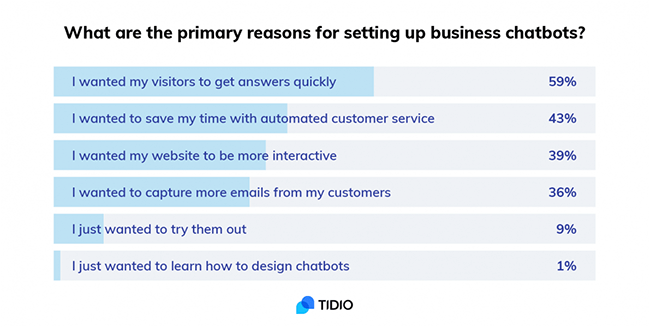
Other cited reasons include wanting to save time with automated customer service (43%), wanting their website to be more interactive (39%), and wanting to capture more emails from customers (36%).
Some businesses just want to try out chatbots or learn how to design chatbots.
Source: Tidio
16. Chatbots are widely accepted at retail shops
Out of all the industries out there, retailers seem to have the biggest success as far as the implementation of chatbots goes. 34% of customers have no problem using AI chatbots when making online purchases or inquiries.
Other industries, especially those that are connected to financing, seem to struggle. For instance, the insurance industry is only getting an acceptance rate of 15%. Financial advice and banking aren’t faring much better — both are at 20%.
27% of consumers are also fine with the use of chatbots in the healthcare industry.
Source: Startup Bonsai
Chatbot technology: statistics and facts
Chatbots are everywhere. But despite their popularity, they’ve yet to hit their full potential. People can do so much more with chatbots. Soon, they’ll be used for use cases outside of customer support.
In fact, some organizations are already using chatbots for other tasks. And if people invest in the technology some more, who knows how they’ll be used in the future.
Here are some statistics and facts about chatbot technology.
17. Chatbots are used to train crisis counselors
In an example of just how powerful AI chatbots can be, The Trevor Project is now using chatbots to train counselors that will go on to join its 24/7 helpline.
The chatbot can mimic an at-risk LGBTQ youth that’s struggling with depression and suicide as well as other scenarios. The goal is to expose the counselors to a wide range of situations much more quickly in preparation for their roles in the organization.
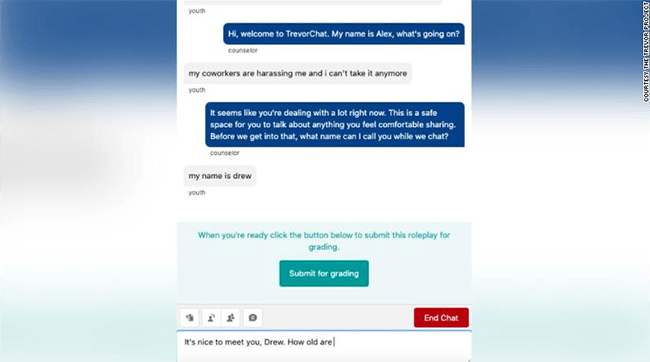
There are still limitations to the technology though. For instance, AI can’t answer some questions. Or if it does, it’s unable to answer it well. However, this might be a good thing for the counselors as it’s training them to rephrase their questions so they get better responses.
Source: CNN Business
18. Chatbots can help dementia patients
Chatbots now have the potential to aid dementia patients and their caregivers. More specifically, chatbots help them improve the communication between patients and the healthcare system.
This is crucial considering how the number of dementia patients increases as people age.
However, progress still needs to be made as it’s still too early for the technology to be completely reliable and useful.
Source: Health IT Analytics
19. Chatbots are beneficial for patients with sensitive conditions
It’s not unusual to find patients who are unable to discuss their health conditions because they find them stigmatizing such as STIs. But that might change thanks to chatbots.
According to research, chatbots might help convince patients to speak with healthcare professionals. As of now, there are limitations to the technology, especially when input is required from patients. But with further studies, chatbot proponents might find a way to bridge that gap.
Source: Digital Health
20. 25% of customer service operations will use chatbots
25% of customer service operations will use virtual customer assistant (VCA) or chatbot technology by 2020. This prediction came from Gartner Managing Vice President Gene Alvarez back in 2018.
To quote the man, “As more customers engage on digital channels, VCAs are being implemented for handling customer requests on websites, mobile apps, consumer messaging apps, and social networks”.
Companies are reporting a 70% reduction in call, chat, and email inquiries after using chatbots.
Source: Gartner
21. Executives said bots increased their ability to handle queries
Accenture reports that about 6 in 10 executives stated that chatbots helped their organization’s ability to handle customer queries. This is because chatbots have the ability to network with others to deliver a personalized experience for customers.
This results in better customer acquisition and retention rates. 61% of executives also reported that chatbots helped improve their employees’ productivity by automatically following up on scheduled tasks. 57% said that bots also facilitated better communication in their respective organizations.
Source: Accenture
Chatbot disadvantages: statistics and facts
Chatbot and AI are the future of commerce. However, some users are having trouble with using the technology today. There are those who aren’t comfortable conversing with a bot and would rather talk to a real person about their inquiries.
There are also people who don’t find them useful since they were unable to help resolve their concerns.
These facts and statistics on chatbot disadvantages will explain why there are those that feel apprehensive about chatbots in general.
22. 60% of users would rather wait for an agent than deal with chatbots
There are people who would rather wait for a live agent than deal with chatbots.
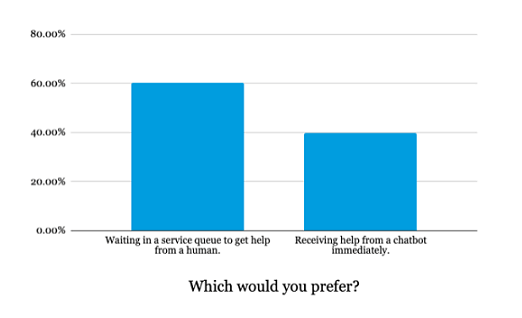
Over 60% of consumers expressed that they’d rather wait in a queue to speak to a person than receive help immediately from a chatbot.
It’s worth mentioning, however, that these consumers said that they will engage a chatbot if it helped them get transferred to an agent.
Source: Startup Bonsai
23. Chatbots ranked last in customer satisfaction
A recent study conducted by Dimensional Research found that chatbots ranked dead last in a list of digital service options. It was outranked by more mainstream solutions like messaging, regular chat, email, and social media.
The problem is that 57% of users were frustrated with the inconsistent answers between chatbots and human-assisted options.
However, the same study shows that 80% of consumers have increased their use of digital services. Millennials and Gen Z users are leading the charge at 92% and 87% respectively. In comparison, Gen X users are at 79% while boomers are at 69%.
Source: Dimensional Research via Global Newswire
24. 54% Found chatbots only somewhat effective at resolving issues
54% of users aren’t that happy with using chatbots. While they didn’t hate it, they described chatbots as only somewhat effective in dealing with their concerns.
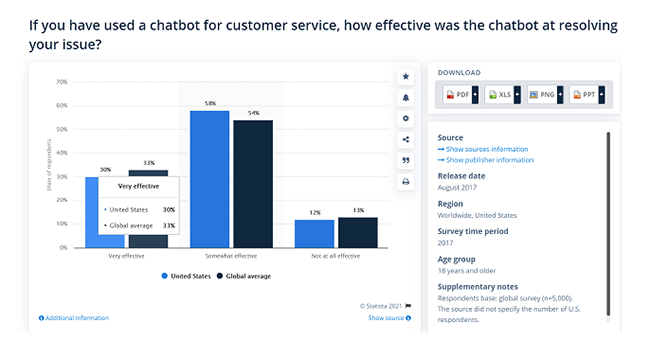
Clearly, more work needs to be done to improve that number. But on the bright side, 34% said that chatbots were very effective at their job. That’s more than the 13% who said that chatbots were not effective at all.
Conclusion
To say that chatbots are crucial for businesses to survive is not a stretch. But we’re still a long way from total chatbot acceptance and dependence. There are still kinks that need to be sorted out.
But we’re slowly getting there.
If you’re interested in building a chatbot for your own business, you can look into the different chatbot builders for businesses. That way, you’ll be able to reap the benefits of having chatbots like automated customer support.
Finally, if you’d like to check out more interesting statistics, have a read of our article on lead generation stats.

